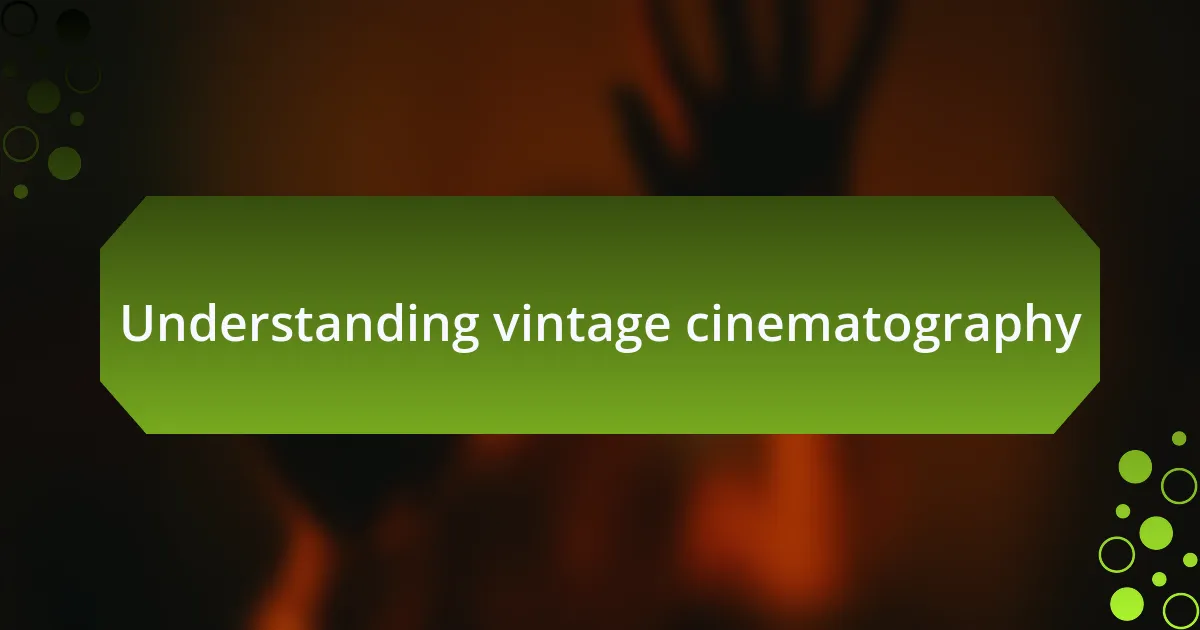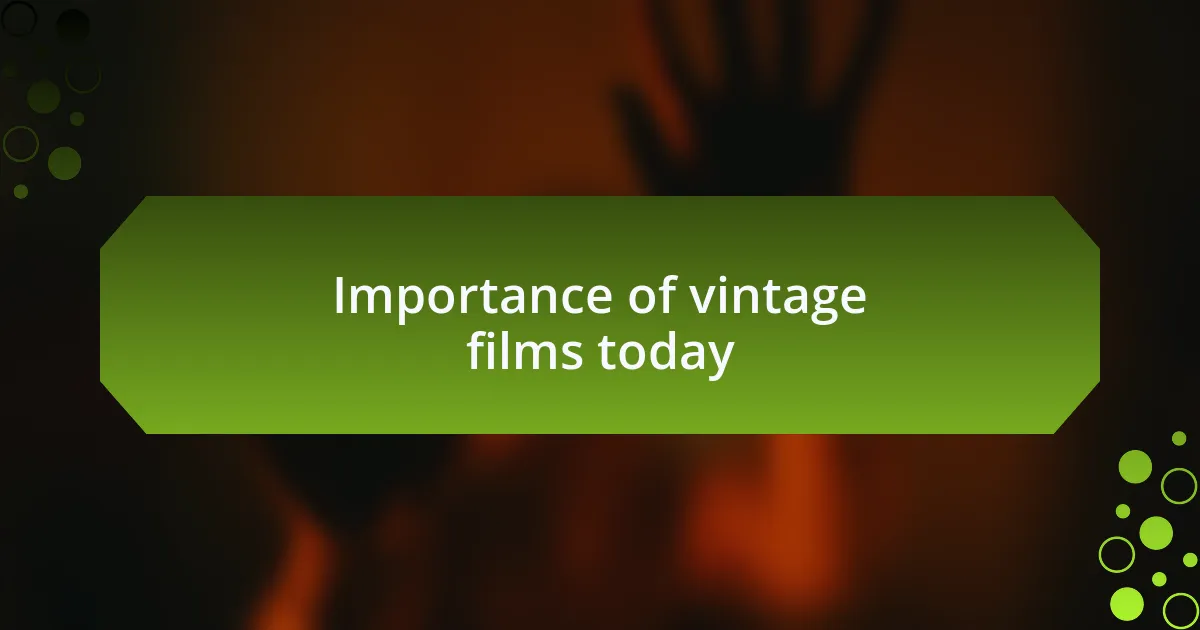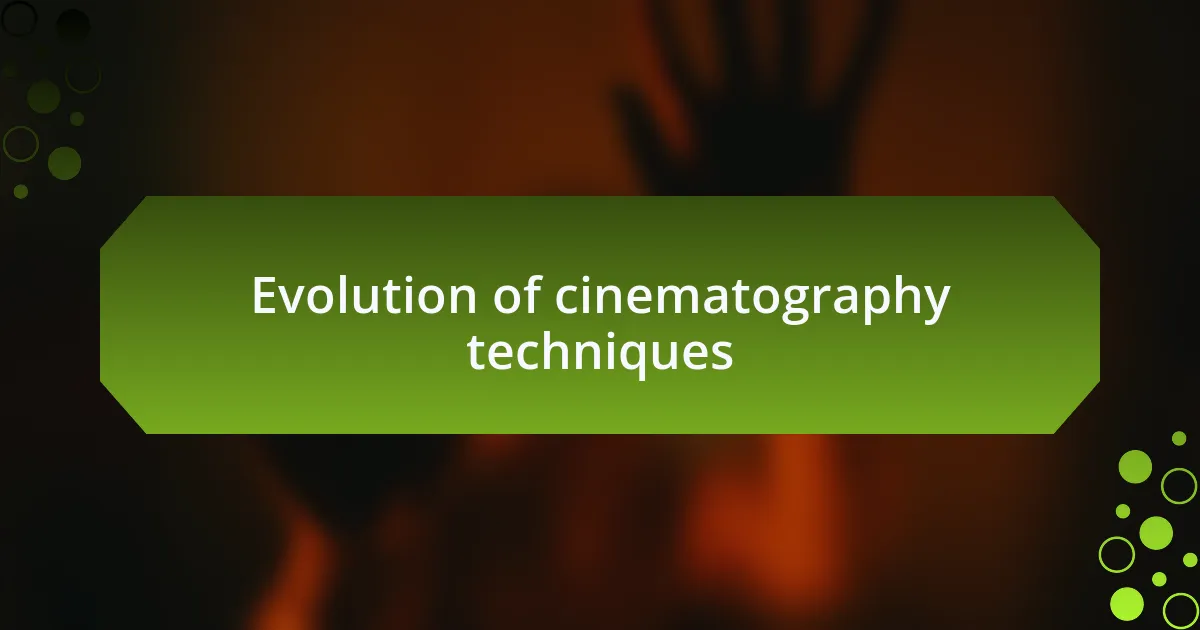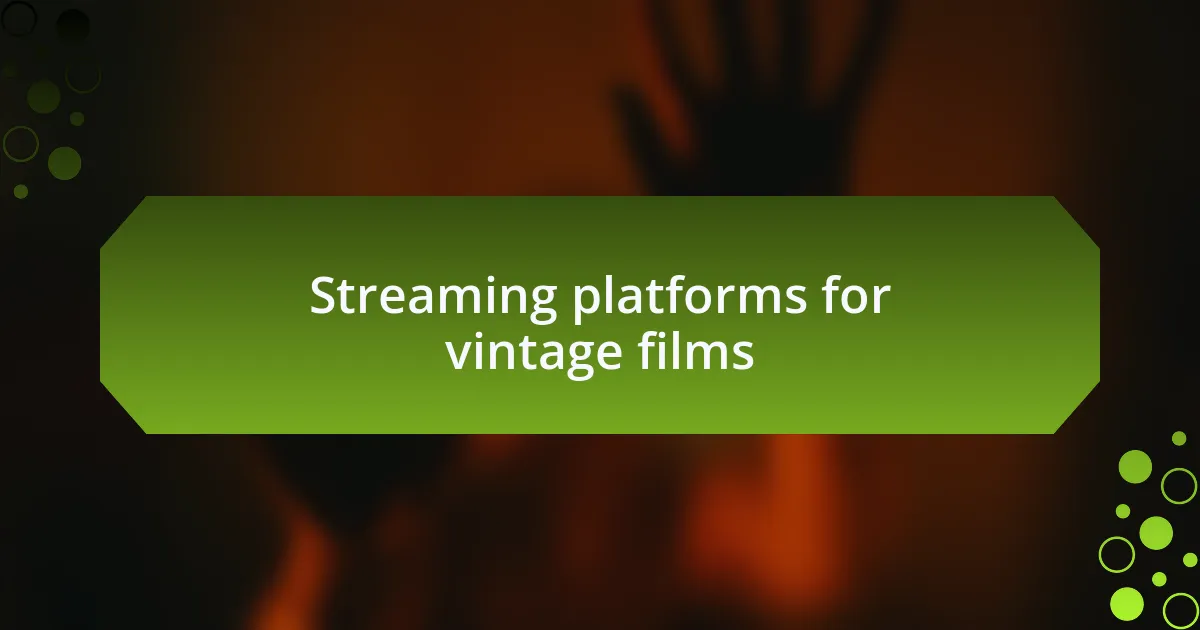Key takeaways:
- Vintage cinematography utilizes practical effects and natural light, offering a nostalgic storytelling experience that influences modern cinema.
- Classic films serve as a bridge to the past, reflecting timeless social struggles and providing inspiration for contemporary filmmakers.
- Cinematography techniques have evolved from silent films to digital, enhancing visual storytelling while retaining the charm of vintage methods.
- Streaming platforms have increased accessibility to vintage films, allowing new generations to discover and appreciate classic cinema.

Understanding vintage cinematography
Vintage cinematography truly captures a unique essence of storytelling. I still remember the first time I watched “Casablanca.” The grainy texture of the film, combined with the luminous lighting, created a mood that felt almost tangible, transporting me back in time. Doesn’t it make you wonder how film techniques of the past continue to influence modern cinema?
The use of practical effects and natural light in vintage films often evokes a sense of nostalgia. I find it fascinating how filmmakers relied on real sets and manual techniques without the conveniences of today’s CGI. Each frame holds a story crafted with precision—how many times have you paused a black-and-white scene, captivated by the shadows and highlights that seem to breathe life into the characters?
Moreover, vintage cinematography offers a glimpse into the culture and aesthetics of its era. When I explore films from the 1920s or 1950s, I’m struck by the intentionality behind every shot. Just think about it—how does the cinematography of those times reflect social norms or artistic expressions of that period? There’s an authenticity that resonates, reminding us of the timeless quality of human emotion captured on film.

Importance of vintage films today
Vintage films hold an essential place in today’s cinematic landscape because they serve as a bridge to our past. I fondly recall the thrill of watching “Sunset Boulevard” for the first time. The haunting portrayal of dreams and failures seemed so relevant that I wondered: how do these timeless stories continue to resonate with audiences today? They remind us that, despite the passage of time, our core struggles and triumphs remain unchanged.
Moreover, vintage films are a treasure trove of inspiration for contemporary filmmakers. When I analyze classics like “The Maltese Falcon,” I’m struck by how the cinematography creates tension and atmosphere without the reliance on modern technology. Isn’t it intriguing to think about how today’s directors can draw from these well-crafted narratives to push creative boundaries? It encourages us to appreciate the artistry behind every decision made in those films.
Finally, vintage cinema allows us to reflect on societal changes and cultural evolution over time. Watching films like “To Kill a Mockingbird” has prompted me to think about how storytelling can be a powerful catalyst for social change. What can we learn from these narratives about our own biases and perspectives? Vintage films challenge us to confront issues that still resonate today, fostering a deeper understanding of human experience through the lens of history.

Evolution of cinematography techniques
Cinematography techniques have evolved dramatically since the early days of film. In the silent era, filmmakers relied heavily on lighting and framing to convey emotion and narrative, which I find fascinating. Just think about films like “The Cabinet of Dr. Caligari”—the artistic angles and stark shadows create such an eerie atmosphere, showing how visual storytelling can be mesmerizing even without sound.
As technology advanced, the introduction of color film in the 1930s revolutionized the artistry of cinematography. Watching “The Wizard of Oz” for the first time, I was captivated by how color breathed life into the story. It made me wonder: how would those scenes have felt in black and white? The vivid hues not only provided beauty but also enhanced the emotional stakes of the narrative, allowing filmmakers to explore new creative depths.
In recent decades, the rise of digital cinematography has transformed how stories are told onscreen. My experience with modern films often has me reflecting on this shift; while I appreciate the clarity and versatility of digital cameras, part of me misses the warm textures of film grains. Is there an irreplaceable charm to those vintage techniques? As filmmakers blend old methods with new technology, this evolution reminds us that, at its core, cinematography is about visual storytelling, regardless of the tools used.

Streaming platforms for vintage films
Streaming platforms have made it surprisingly easy to access vintage films, which is something I truly appreciate. For instance, Criterion Channel stands out for its rich collection of classic cinema, showcasing films that shaped the art form. I remember discovering films like “The 400 Blows” and feeling transported to a different era, immersed in the texture and storytelling style that only vintage films can provide.
Another platform worth mentioning is TCM (Turner Classic Movies), which offers a curated selection of timeless films that reflect the golden age of Hollywood. I often find myself staying up late, captivated by a black-and-white film noir, and wondering how audiences in the 1940s responded to those gripping narratives. It’s like stepping back in time, connecting with a history that feels alive and relevant today.
Don’t overlook services like Amazon Prime and Netflix either; they have surprisingly robust vintage film sections, featuring everything from musicals to early sci-fi. While browsing through their collections, I often get nostalgic about my childhood experiences of watching classic movies on TV—it brings back memories of cozy evenings with family. It’s incredible how streaming has opened the door for a new generation to appreciate these cinematic gems, isn’t it?